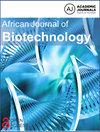Morphological traits variation of cowpea (Vigna unguiculata L. Walp) grown in Cte dIvoire
引用次数: 0
Abstract
The genetic diversity of a genetic resource is an indicator of its richness and offers many possibilities for improvement. Cowpea is an important source of nutrients for humans and animals. This study aimed at assessing genetic diversity and relationships present among 135 accessions in the Centre National de Recherches Agronomiques (CNRA) collection, using qualitative traits. Traits analysis revealed significant genetic variation between the studied accessions through high Shannon diversity index. Estimated for 15 morphological characters with 0.80 mean value, H’ ranged from 0.55 to 1. Seed traits generally expressed mean high diversity index (0.70-0.89). Between 15 parameters assessed, 12 exhibited the most discriminating variability of collection. The three MCA factorial axes explained 19.085% of phenotypic variability. The trait seed colour being correlated to these axes could be used as a selection criterion for local cowpeas improvement. Based on MCA and HAC methods, these accessions were classified into three distinct groups. Containing most accessions, subgroup Ia includes all seeds, pod, and flower colours. Almost all accessions of subgroup Ib possessed cream-coloured, smooth and globose seeds. All cluster II accessions have a creeping habit. The CNRA collection being very diversified, it constitutes a useful resource for future cowpea improvement studies in Côte d'Ivoire.科特迪瓦种植的豇豆(Vigna unguiculata L. Walp)的形态特征变异
遗传资源的遗传多样性是其丰富程度的指标,并为改良提供了许多可能性。豇豆是人类和动物的重要营养来源。本研究旨在利用定性性状评估国家农艺研究中心(CNRA)收集的 135 种豇豆的遗传多样性及其相互关系。性状分析表明,通过高香农多样性指数,所研究品种之间存在明显的遗传变异。据估计,15 个形态特征的平均值为 0.80,H'在 0.55 至 1 之间。在所评估的 15 个参数中,有 12 个参数表现出最明显的多样性。MCA 的三个因子轴解释了 19.085% 的表型变异。种子颜色性状与这些轴相关,可作为当地豇豆改良的选择标准。根据 MCA 和 HAC 方法,这些品种被分为三个不同的组。Ia 亚组包含了大多数品种,包括所有种子、豆荚和花的颜色。Ib 亚组的几乎所有品种都有乳白色、光滑和球形的种子。第 II 组的所有品种都具有匍匐生长习性。国家豇豆研究所收集的豇豆品种非常多样化,是科特迪瓦未来进行豇豆改良研究的有用资源。
本文章由计算机程序翻译,如有差异,请以英文原文为准。
求助全文
约1分钟内获得全文
求助全文

 求助内容:
求助内容: 应助结果提醒方式:
应助结果提醒方式:


